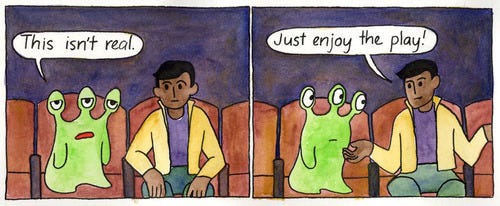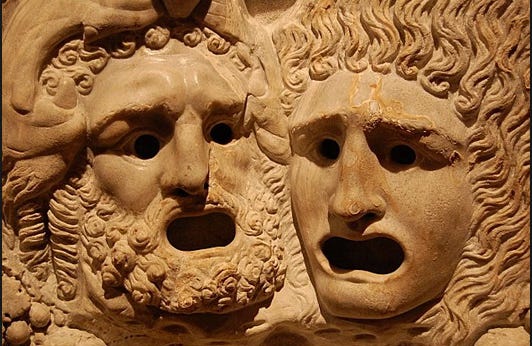All live theatre requires a pretty heavy suspension of disbelief on the part of an audience. Setting aside the construct of sitting in rows gazing through a Proscenium Arch (™ Ancient Greece), we know we’re not actually watching real people in a real life scenario, but for the sake of a good time (FOR GOD’S SAKE) we’ll go with it as if we are.
This feels even more important on an improv stage. Any show could require the performers to set a scene a wide range of locations from an office break room (yawn, again!), via a science lab, inside a dog’s mouth, to the surface of a rusty coin. All perfectly normal improv settings. There’s generally not much in the way of props, sets or costumes to conjure these - even the most ‘produced’ genre shows necessarily do this in a light way to give the performers as many options as possible (usually, hats or a costume that can be many statuses of character). If we’re going to enjoy watching a show, we need to let go of a few of those details not being 100% there.
In fact, it’s probably improvised genre shows that depend most on the ‘Suspension of Disbelief’ (™ Ancient Greece, top theatre lads). Audiences obviously know they’re not watching an actual authentic Harry Potter story, Studio Ghibli film, medical drama, or whatever else the show is leaning on to shift some tickets. If they don’t know that, pray for them.
But they’ll go along with some pretty wild and implausible storylines and happening, as long as they can recognise some cornerstones of the genre generally. A romcom needs a meet-cute, we’ve got to see some wands being waved around in the Wizarding World, a sports show needs a training montage and so on.
The idea I pitched for improvised cop show The Badge in 2019 came from the massive number of police taped interview scenes I was seeing as a go-to in normal long-form shows - usually as a nice off the peg second-beat option. You’ll need some of those interview scenes in the mix of any show set in a police world. Ironically the eventual genre show we devised had very few of these. They’re pretty one note and not necessarily great for improv once you’ve done 10 of them: cops struggling to work the tape, good cop/bad cop, perps denying what they’ve done, the scene summarising stuff we’ve already seen etc.
For St Doctor’s Hospital, we tried to approximate an opening credits sequence a la Grey’s Anatomy, with an earnest voiceover narration over some silent vignettes of swooning Docs taking things very seriously. Directing Winner (improv sports biog), I re-purposed a monologue style opening so it looked like a supercut of talking heads in a classic sports documentary like The Last Dance. Yes, we took it personally.
You’ve got to be careful though. One thing that can puncture a nicely crafted Suspension of Disbelief is a lack of commitment from the performers to the honest truth of the genre. We all know what we’re doing is ridiculous. Pratting about with fake American accents pretending to study crime scenes or use a defibrillator to crank ourselves before hitting the gym is not serious behaviour.
But there’s a fine line to straddle for the performers between acknowledging that silliness, or puncturing it by an out-of-character, fourth wall breaking, comment on the show from within, or on another improviser’s mad choice. This particularly happens near the end of shows aiming for coherent narrative, as ever more convoluted attempts to tie things together are made. The Fourth Wall (™ Ancient Greece again, AND they have great souvlaki. Those guys…) can quickly disintegrate with unguarded responses in-scene like ‘Really?’, ‘Are you sure?’, or some quip that the characters themselves could never say, only an improviser judging their own show.
The Suspension of Disbelief show requires that you stay in the conceit you’ve created, for the benefit of the audience and the show’s continuity (yummm continuity, so fun). I like to see it as ‘honouring’ the scenes and show you’ve created, and ‘honouring’ the choices of your teammates.
On the other hand, most of the time we’re ultimately trying to do a comedy show. It’s not my tempo, but it can be a legitimate approach to do anything it takes to get laughs in the moment, even if it ‘harms’ the overall narrative. Why not take your Charles Dickens show to space if it feels fun? An improv show can sustain that in a way a novel or TV show wouldn’t usually attempt, so we can make a virtue of that freedom.
So I don’t actually know: What do you think? How much or little of the performers’ real selves do we need to see during a show? When does it help and when is it a problem? Go off!

ENDNOTES
Performing: Do Not Adjust Your Stage are taking a couple of Wunderkammer shows to the excellent Great Exhibition Road Festival at Imperial College on Sat 7 June. It’s FREE! Sign-up here.
Another thing:
FIVE 100% real screen-writing books that WILL LEVEL-UP your CAREER
‘SHUT THE F*CK UP AND WRITE!’ By Cal Grissom
‘A Bit of Blue: taboo solutions to taboo screenwriting problems’ by Sherman Goodlight
‘The Page 27 Rule: Fix your screenplay by ensuring your protagonist eats a snack on page 27’ By Mitch Guber
‘You Suck! 123 reasons why you suck’ by Mallory Pengevich
‘Nepo your way to RepPo: Daddy’s little black book of agents’ by The Cast of SNL (not on general sale)





